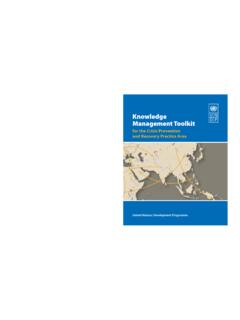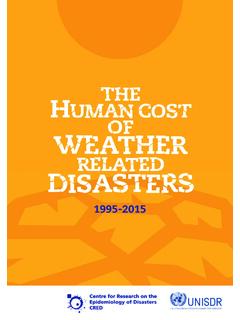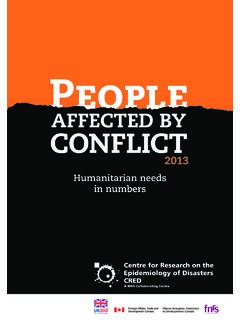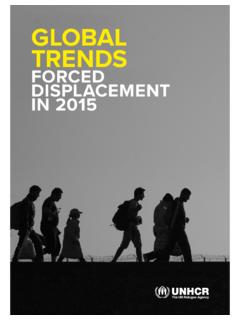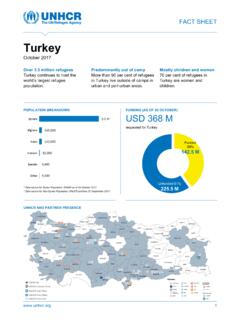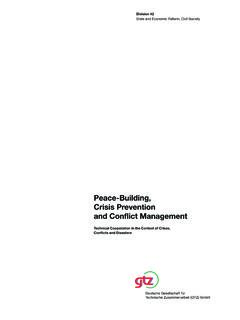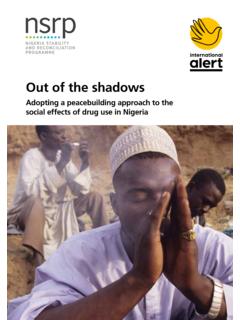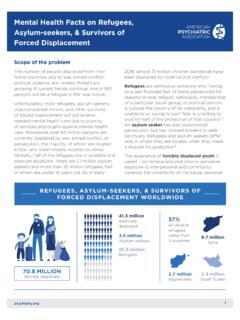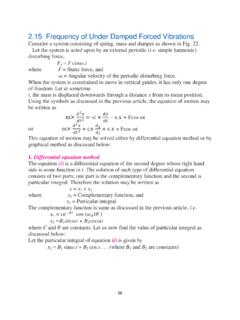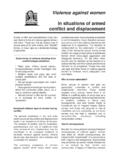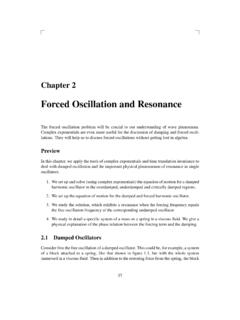Transcription of WorldRiskReport - ReliefWeb
1 WorldRiskReport 2020 Focus: forced displacement and MigrationPublisher WorldRiskReport 2020B ndnis Entwicklung HilftandRuhr University Bochum Institute for International Law of Peace and Armed Conflict (IFHV)Concept, implementation and editingB ndnis Entwicklung Hilft: Peter Mucke, Project Leader Lotte Kirch and Ruben Pr tz, Editors in Chief Leopold Karmann, AssistanceIFHV: Dr. Katrin Radtke, Scientific Lead MediaCompany:Julia Walter, Consulting and EditingAuthorsBenedikt Behlert, IFHVR ouven Diekjobst, IFHVDr. Carsten Felgentreff, Osnabr ck UniversityTimeela Manandhar, IFHVP eter Mucke, B ndnis Entwicklung HilftProf. Dr. Ludger Pries, Ruhr University BochumDr. Katrin Radtke, IFHVD aniel Weller, IFHVIn collaboration withClaudia Berker, terre des hommesSvea Br ck, IFHVS abine Minninger, Brot f r die WeltHendrik Slusarenka, medico internationalGraphic design and information graphicsNaldo Gruden, MediaCompanyISBN 978-3-946785-10-1 The WorldRiskReport has been published annually since 2011 by B ndnis Entwicklung HilftResponsible: Peter MuckeImprintWorldRiskReport 2020 2 Foreword Nothing is shaping the year 2020 as strong-ly as the Covid-19 pandemic.
2 It determines our everyday life, our actions and our social interactions. Its long-term consequences are as yet unforeseeable. The news is dominated by it, while other no less important issues are receding into the background. These include the main topic of this year s WorldRiskReport , forced displacement and Migration . The figures published this summer by the UN Refugee Agency are alarming: almost 80 million people are currently fleeing their homes, and refugees at the EU s external borders and inter-nally displaced persons in their own countries continue to die every day. Time and again, it becomes clear that the risk of displacement and risks during forced displacement are unevenly distributed globally as well as within soci-eties.
3 The Covid-19 pandemic further exacer-bates the situation of refugees and displaced persons. Social distancing simply cannot be followed in overcrowded refugee camps such as Moria on the Greek island of Lesbos or in Cox s Bazar in Bangladesh. The people there, who are in particular need of protection in any case, are experiencing a crisis within a natural events also often hit the poor-est and most vulnerable members of society hardest, including refugees and migrants. Climate-related extreme weather events are increasing in frequency and intensity in many places, forcing more and more people to leave their homes. This year s WorldRiskReport brings this issue to the fore and demonstrates the need for climate justice and is the only way to prevent many more people from having to leave their homes in the future due to irretrievably destroyed liveli-hoods and losing their basis of existence.
4 The WorldRiskReport has been published annually since 2011 by B ndnis Entwicklung Hilft. Since 2017, the Institute for International Law of Peace and Armed Conflict (IFHV) at the Ruhr University Bochum has been responsible for the scientific management and calculation of the WorldRiskIndex contained in the report. As a member of the Network on Humanitarian Action (NOHA), the IFHV ensures the inter-national anchoring of the index in science. Building on the exchange between science and practice, we jointly pursue the goal of main-taining and increasing the usefulness of the WorldRiskReport as an instrument and guide-line for decision-makers in politics and Dr. Pierre Thielb rgerExecutive Director IFHVWolf-Christian Ramm Chairman B ndnis Entwicklung HilftB ndnis Entwicklung Hilft is formed by the aid organizations Brot f r die Welt, Christoffel-Blindenmission, DAHW, Kindernothilfe, medico interna-tional, Misereor, Plan International, terre des hommes, Welthungerhilfe and the associated members German Doctors and Oxfam.
5 In contexts of crisis and disasters, the member organizations provide short-term relief as well as long-term support in order to overcome poverty and prevent new crises. The Institute for International Law of Peace and Armed Conflict (IFHV) of Ruhr University Bochum is one of the leading institutions in Europe for research and teaching on humanitarian crises. Coming from a long tradition in scientific analysis of international humanitarian law and human rights, the Institute today combines interdisciplinary research in the fields of law, social science, geoscience, and public health. 3 WorldRiskReport 2020 Further informationIn-depth information, methodologies, and tables are available at The reports from 2011 2019 can be downloaded there as well.
6 WorldRiskReport 2020 4 WorldRiskReport 4 Contents Foreword .. page 3 Key Results .. page 61. Disaster Risk, forced displacement and Migration .. page 9 Peter Mucke2. Focus: forced displacement and Migration .. page 17 Extreme Natural Events, Climate Change and Migration .. page 17 Ludger Pries Migration, forced Immobility and Return In Times of Coronavirus .. page 24 Carsten Felgentreff Impact of the Covid-19 Pandemic and Extreme Natural Events on Refugees and Displaced Persons .. page 30 Timeela Manandhar Human Rights as Means to Challenge Climate Change Injustices .. page 35 Benedikt Behlert, Rouven Diekjobst3. The WorldRiskIndex 2020 .. page 43 Katrin Radtke, Daniel Weller4. Recommendations and Demands.
7 Page 53 B ndnis Entwicklung Hilft, IFHVA ppendix .. page 57 Bibliography .. page 64 5 WorldRiskReport 2020 5 WorldRiskReport 2020 Key ResultsWorldRiskIndex 2020 +The WorldRiskIndex 2020 indicates the disaster risk for 181 countries in the world. The Pacific island state of Vanuatu leads the index as the country with the highest disaster risk ( ). Qatar has the lowest risk ( ). +The disaster risk is very heterogeneous world-wide, but geographically highly concentrated. In 2020, the hotspot regions of risk are still locat-ed in Oceania, South-East Asia, Central America and West and Central Africa. +Comparing the continents, Oceania ranks first in terms of disaster risk, followed by the Americas, Asia and Europe. +Oceania is also the continent with the high-est exposure to extreme natural events.
8 It is followed by the Americas, Africa, Asia and Europe. +In general, island states, especially in the South Pacific and the Caribbean, are disproportionate-ly represented among the high-risk countries. This is generally due to their high exposure to extreme natural events. These also include the rise in sea level as a result of global warming. +Africa is the focus of social vulnerability. More than two-thirds of the world s most vulnera-ble countries are located there. Among them, the Central African Republic being the country with the highest vulnerability in international comparison. +In the ranking of vulnerability, Africa is followed by the continents of Oceania, Asia, the Americas and Europe in descending order.
9 +Germany ranks 162nd in the WorldRiskIndex. With an index value of , Germany has a very low disaster risk. With a median of for 43 countries, Europe has by far the lowest disaster risk of all continents. +In 2020 a new country could be included in the WorldRiskIndex due to expanded dataset: The island state of Dominica ranks third with its very high-risk score of 1: WorldRiskIndex 2020 WorldRiskReport 2020 6 WorldRiskReport 6 Focus: forced displacement and Migration +Extreme natural events such as floods or storms increase the probability of forced migration. Based on current information, global warming and the resulting changes in environmental factors and extreme weather conditions also lead to complex migration movements.
10 +Conversely, massive migration processes can contribute to accelerating climate change. This is particularly true for rural-urban internal migration, as growing cities bring with them, among other things, temperature changes. +The prerequisites for coping with crises whether caused by extreme natural events or a pandemic such as currently Covid-19 differ worldwide. While, for example, contact restric-tions in Germany slowed down the spread of Covid-19, the imposed curfew in India increased the risk of infection due to different initial conditions. +Vulnerable groups like the migrant workers in India are often left to their own devices in crises and disasters like the Covid-19 pandem-ic.
